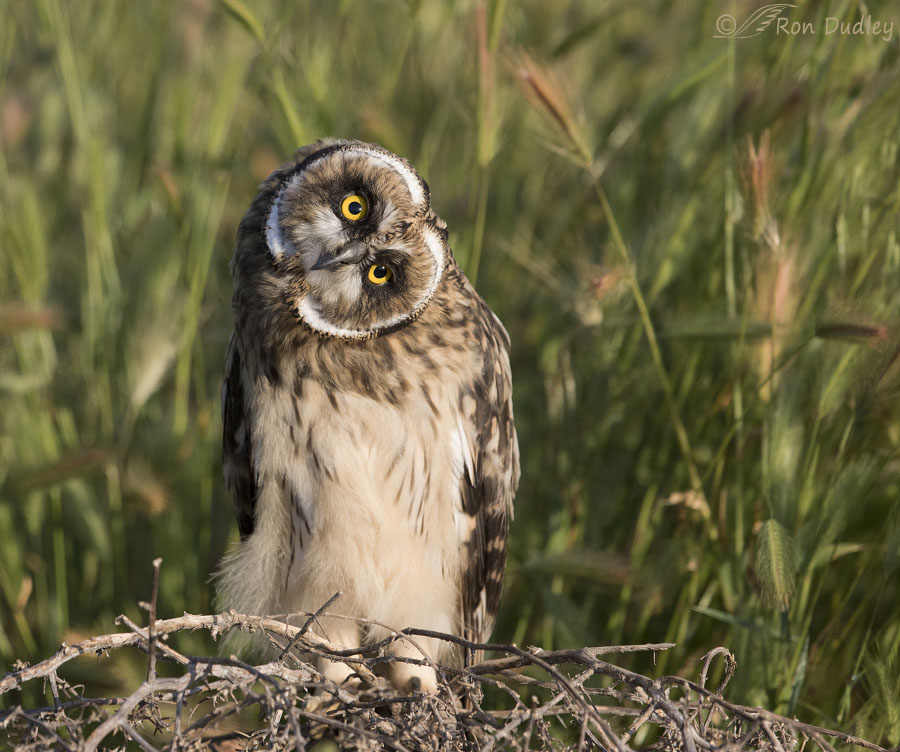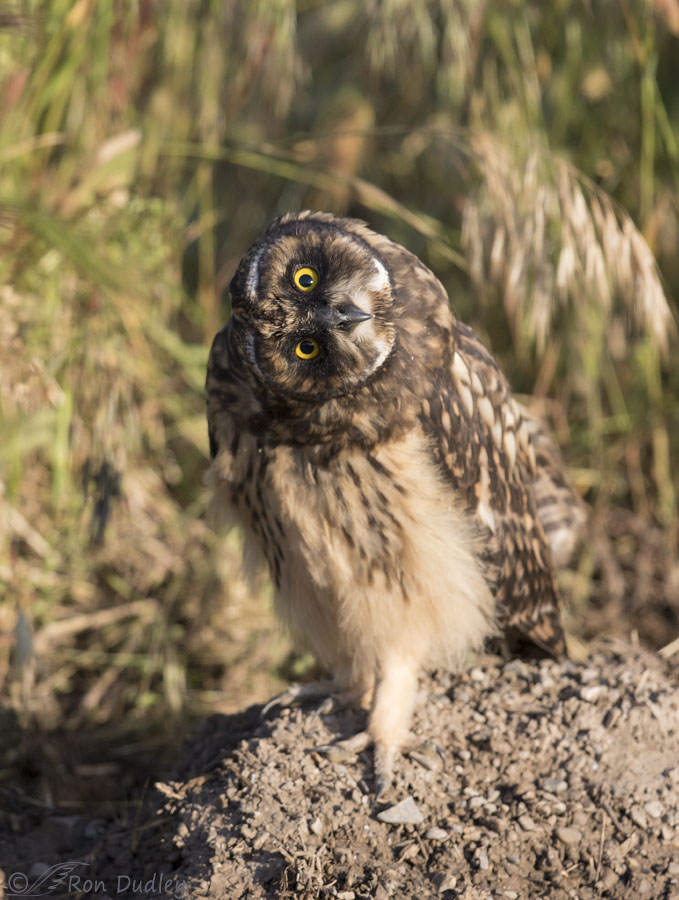Few subjects have more appeal than curious Short-eared Owl youngsters, especially when they’re bobbing their heads into weird positions.

1/3200, f/7.1, ISO 800, Canon 7D Mark II, Canon EF 500mm f/4L IS II USM, not baited, set up or called in
I photographed these two about two years ago (5/30/16) in northern Utah. This one was perched on top of an upside down tumbleweed right next to the road. Short-eared Owl chicks leave the nest at the very tender age of 12-18 days and wander on foot until they fledge (first flight) at about 27 days of age – if these siblings had actually fledged they’d done so very recently. Neither of them exhibited any fear at all of my pickup and that concerned me with them so very close to the road (so close that I couldn’t fit its virtual tail in the frame).
These youngsters were both using parallax on my pickup – moving their heads, bobbing them rhythmically from side to side, then forward, then back. Sometimes their heads were almost completely upside down and during the entire performance they kept their eyes locked on me. Audubon describes the behavior as follows:
- “All these varied head movements help the owl judge the position and distance of things around it—essentially, to triangulate on objects, including potential prey, and to build a composite picture of its surroundings. This head-bobbing helps make up for an anatomical limitation: An owl’s eyes are fixed in position, so they simply can’t move (in the skull) the way our eyes do. To look up, down, or to the side, an owl has to move its head. They have very flexible necks and can do 270 degrees of a full head turn, looking over one shoulder, around the back, and almost over the opposite shoulder. And after a few of these head-bobs to triangulate on their prey, they rarely miss.”
Interpreting the results of parallax takes learning and practice so very young owls do it much more often than adults.
 1/2000, f/7.1, ISO 400, Canon 7D Mark II, Canon EF 500mm f/4L IS II USM, not baited, set up or called in
1/2000, f/7.1, ISO 400, Canon 7D Mark II, Canon EF 500mm f/4L IS II USM, not baited, set up or called in
The other youngster was only a few feet away on a pile of dirt and at a steeper angle to me. At this close distance I didn’t have enough depth of field to get its entire body sharp but I wanted to show that this one was using parallax on my pickup too.
Normally I wouldn’t get anywhere near this close to wild owls of any age but they were so close to the road I had no practical choice. Besides I was actually hoping that the nearness of my pickup would cause them to move off into the thick grasses and further away from the road but typical of very young owls they showed no fear. It’s far from unusual for me to find road-killed owls in this area.
Thankfully the road had very little traffic in the early morning and the next time I drove by a couple of hours later they were nowhere to be seen.
Ron
PS – For those who may be wondering I was actually able to get my epidural yesterday afternoon despite my episode in the emergency room the day before. They almost wouldn’t allow me to have it.


Wonderful photos! I have never seen such young Short Eared Owls! Thank you for sharing then!
I’m glad you enjoyed them, Jerilyn. Thanks.
Beautiful photos Ron. I love when owls twist their heads all around.Thank you.
Thank you, Debbie.
DRAT! Once again I wrote a spectacular post (I can dream) and it went off into the ether somewhere. DARGH!
Lovely photos, as usual. That head thing always gets me. Yes, I know about the scientific and anatomical adaptations to make that happen and why, but still. I’m SO easily amused. Imagine being able to triangulate! Just WOW (and it’s cute, too).
Like EC and everybody else, I’m all crossed up–fingers, arms, legs, toes, eyes, brain, the whole shebang–hoping this epidural gives you rapid relief. And there’s a sight you don’t want to see, although it could be good for a good belly laugh 😉
Thinking of you and keeping you wrapped in my heart.
Thanks, Laura. I keep reminding you, copy into your clipboard before you post a long comment! 🙂 That’s what I do.
Yeah, that would be like backing up. I’m not good at that, either. You’d THINK I’d have learned by now. But to be fair, the important stuff is up on a cloud somewhere 😉
Too many owls would be barely enough. I am a sucker for them all. And hope to visit a barking owl later this year who (after rehabilitation) is making its home at our local zoo. This gives a link to their call.
I will cross everything (fingers, eyes, toes) that the epidural brings you some relief.
Wow, that sure doesn’t sound like any owls we have around here, EC!
WOW! Your critters are really different from here EC! Thanks for that link. You’ve satisfied my need to learn something new every day.
Now, off to clean bird poo-poo, then feed ’em again so they make more 😉
These guys are cute, but my all-time favorites for parallaxing are Burrowing Owls. That said, I might feel differently if I actually got to see SEOs in person. It must be fun to watch them parallaxing.
Burrowing Owls are a lot of fun too, Susan. Not sure which ones I enjoy most.
Wonderful shots, Ron. It’s so much fun to watch youngsters explore their environments! That’s one of the reasons I love fostering puppies and kittens so much — I get to see the excitement of that exploration through their eyes.
Here’s hoping your epidural works and you’re back to normal very, very soon!
“It’s so much fun to watch youngsters explore their environments”
Agreed, Marty – no matter the species!
I love these short ears…they are such essential “owlness”. Good news about getting the epidural…hope it helps…
Time will tell, Patty. Thanks.
Thanks for bringing joy to my morning, Ron! Hope your road to recovery is a short one!
Thank you, Diane.
The head turning has always fascinated me.
Me too. And enchanted me when it happens with chicks.
Thanks for the explanation for the “parallax peering”– now I understand the reason for this endearing weirdness ! It was good to see “Feathered Photography” on my
e-mail line-up this morning, and I hope the epidural kicks in sooner rather than later.
Thanks, Kris. I’m glad that info was interesting for you.
Wonderful shots Ron! Hope you’re feeling better.
Charlotte
Thank you, Charlotte.
Saw these signs on a trip to Sanibel. Wonder if it could help in your area? http://santivachronicle.com/Content/Default/Outdoor/Article/SANTIVA-TODAY-Low-Flying-Owl-Signs-Work-in-More-Ways-than-One/-3/35/5334
Thanks for letting your virtual friends know about your trials. I have had both crazy bp and back pain, so my sympathy is very heartfelt!
Interesting concept, Mary. However I have my doubts that they’d be effective in this particular area.
Beautiful photos Ron – love those eyes. Get well – stay healthy.
Everett Sanborn, Prescott AZ
PS: went to an Audubon meeting last night and the speaker from the Forest Service listed a number of birds and animals that are now considered “threatened” – at least here in AZ. One was the Spotted Owl. I have never seen one – do you ever see them in your area?
Nope, I’ve never seen one, Everett. I think they have them in southern Utah but they’ve always eluded me.
Be Still My Heart! 😍 These are beautiful and beyond! I shall earmark this post when I need my ‘ShortEar Fix’. I’ve never seen a chick…adults arrive here in late fall and leave in the spring to have the young…don’t know exactly where they go. I do have a few photos of the adults ‘parallaxing’ and those eyes do seem to be attached to you; and I too worry when the adults are so close to the roads…a Snowy was killed nearby this past winter by a highway. For curiosity, what was the height of these little ones at this point? Glad to see your post this a.m! I hope you are doing better and get to the bottom of the problem. As a retired R.N., one never stops thinking about symptoms and surmising.
Thanks, Kathy. I’d say these young birds were about the same height as the adults, though plumper.
Cool! I NEVER tire of watching young owls doing the parallax thing! 🙂 🙂 Good they got out of the road before traffic got heavy. They are SO funny learning about their world. Don’t have any GHO’s this year tho did see a family in the cemetery yesterday while doing graves – pretty far advanced. 🙂 Glad they allowed you to get the epidural! Hopefully it’s helping?
Judy, I talked to one local who said they hit owls with their vehicles “all the time”. Very disturbing.
It’ll take at least 2-3 days for the epidural to have any effect, if it helps at all.
Amazing shots Ron!
Thanks, Xavier.